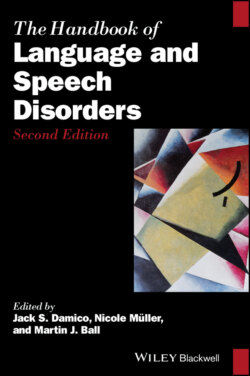Читать книгу The Handbook of Language and Speech Disorders - Группа авторов - Страница 65
4.5 Perceptual Learning
ОглавлениеHistorically, there has been a strong emphasis on the study of the speech signal and on disorder characteristics of the speaker to understand and explain intelligibility deficits. This is observed in the clinic, with efforts to manage intelligibility impairments focused largely on the speaker. For example, for clients with dysarthria and an associated intelligibility deficit, the target is often to improve the speaker’s production of speech or give them strategies and/or technology to compensate for the impairment (Duffy, 2012). However, the past decade has seen a surge in studies that examine listeners and their contribution to intelligibility and potential remediation of impairment. Focusing on the role that listeners play in the construct of intelligibility may lead to new interventions that adjunct traditional speaker‐focused treatments or intervention alternatives when the speakers themselves are not viable treatment candidates.
When listeners encounter speech that is difficult to understand, they rapidly adapt their perceptual systems, mapping the non‐canonical acoustic cues onto linguistic categories stored in memory (i.e., cue‐to‐category mapping). This is known as perceptual learning. According to theoretical models, the cue‐to‐category mapping process is driven by signal predictability (Kleinschmidt & Jaeger, 2015). So long as there is some level of regularity in the degraded speech signal, perceptual learning should transpire. Listeners can and do adapt to the speech of speakers with dysarthria, even when significant intelligibility impairment exists. Empirical studies report statistically and clinically significant intelligibility improvements, ranging from 8 to 20 percentage points, for listeners who receive a brief familiarization experience with audio recordings of a speaker with dysarthria (e.g., Borrie & Schäfer, 2015; Borrie et al., 2012; Liss et al., 2002). This rapid perceptual adaptation to a speaker with dysarthria has been primarily studied with young, normal‐hearing adult listener populations. However, preliminary evidence indicates that older adults, including those with impaired hearing, also experience intelligibility improvements following familiarization with a speaker with dysarthria (Lansford, Luhrsen, Ingvalson, & Borrie, 2018). Further, while existing research in this area has heavily focused on how listeners learn and adapt to the speech of a specific speaker with dysarthria, recent evidence shows that familiarization with one talker with dysarthria can generalize to intelligibility improvements in a novel talker with dysarthria, with the level of intelligibility improvements regulated by the similarity of speech deficit (Borrie, Lansford, & Barrett, 2017a). Although additional studies are warranted, the theoretical and clinical implications of perceptual learning generalization across speakers who share similar patterns of impairment are many. While there is strong collective evidence that listeners perceptually adapt to the impaired speech signals of speakers with dysarthria, there may be a small subset of speakers, those with largely unpredictable speech features (i.e., the hyperkinetic speech patterns associated with the involuntary movements of Huntington’s disease) that listeners simply cannot learn (Borrie, Lansford, & Barrett, 2018; Lansford, Borrie, & Barrett, 2019).
